EventHandling for iOS(中)
By on September 30, 2015
EventHandling for iOS 总结
一,想法
昨天写了一个iOS时间机制上,现在写个中,补齐一下。。。。
二,Regulating the Delivery of Touches to Views
 手势识别会优先获得分析一个touch事件的机会,假如你有一个两个手指触摸的不连续的手势识别,那这个过程如下。
1)window 通过touchesBegan:withEvent:方法发送给gesture recognizer. 设置状态为possible.然后window 把相同的touches事件发送给相应的view
2) window 把移动的触摸事件发送给gesture recognizer. 这里还是不能识别,所以状态依然是possible,同样会把事件再给view
3)window 发送一个touch的事件给gesture recognizer,这里window会hold住不发送给view.
4) window 发送另一个touch(咋是两个手指)的事件给gesture recognizer。现在识别了这个手势,并且设置状态为recognized。接着调用
touchesCancelled来取消view先前的识别动作
手势识别会优先获得分析一个touch事件的机会,假如你有一个两个手指触摸的不连续的手势识别,那这个过程如下。
1)window 通过touchesBegan:withEvent:方法发送给gesture recognizer. 设置状态为possible.然后window 把相同的touches事件发送给相应的view
2) window 把移动的触摸事件发送给gesture recognizer. 这里还是不能识别,所以状态依然是possible,同样会把事件再给view
3)window 发送一个touch的事件给gesture recognizer,这里window会hold住不发送给view.
4) window 发送另一个touch(咋是两个手指)的事件给gesture recognizer。现在识别了这个手势,并且设置状态为recognized。接着调用
touchesCancelled来取消view先前的识别动作
假如这边识别失败咯,这里gesture recognizer会设置状态为UIGestureRecognizerStateFailed,并且会把两个touch的结束事件交给view。 对于一个连续的手势,这里window会把事件全部交给gesture recognizer.
Affecting the Delivery of Touches to Views 这里你可以用过改变一些参数,来调整这么一个touches传递的过程。 delaysTouchesBegan(default of NO),为NO的是时候,是在touch Began阶段并不会传递touches事件给相应的view。 这里确保在gesture recognizer 识别出来手势之前,不会有touch事件给view。(这里有些不清楚)
delaysTouchesEnded(default of YES) 这里主要是在上面说得第3点得时候,如果是YES,这里会hold住事件。如果设置为NO,这里会同时发送给view.
Creating a Custom Gesture Recognizer
这里当然需要有一些自定义的手势识别,这里需要创建一个UIGestureRecognizer的一个子类。
- (void)reset;
- (void)touchesBegan:(NSSet *)touches withEvent:(UIEvent *)event;
- (void)touchesMoved:(NSSet *)touches withEvent:(UIEvent *)event;
- (void)touchesEnded:(NSSet *)touches withEvent:(UIEvent *)event;
- (void)touchesCancelled:(NSSet *)touches withEvent:(UIEvent *)event;
这里主要实现上面这些方法,用来把一些低级别的touch事件转化成手势这种高级的方式。
苹果这里举出了一个例子,可以参考一下。
#import <UIKit/UIGestureRecognizerSubclass.h>
// Implemented in your custom subclass
- (void)touchesBegan:(NSSet *)touches withEvent:(UIEvent *)event {
[super touchesBegan:touches withEvent:event];
if ([touches count] != 1) {
self.state = UIGestureRecognizerStateFailed;
return; }
}
- (void)touchesMoved:(NSSet *)touches withEvent:(UIEvent *)event {
[super touchesMoved:touches withEvent:event];
if (self.state == UIGestureRecognizerStateFailed) return;
UIWindow *win = [self.view window];
CGPoint nowPoint = [touches.anyObject locationInView:win];
CGPoint nowPoint = [touches.anyObject locationInView:self.view];
CGPoint prevPoint = [touches.anyObject previousLocationInView:self.view];
// strokeUp is a property
if (!self.strokeUp) {
// On downstroke, both x and y increase in positive direction
if (nowPoint.x >= prevPoint.x && nowPoint.y >= prevPoint.y) {
self.midPoint = nowPoint;
// Upstroke has increasing x value but decreasing y value
} else if (nowPoint.x >= prevPoint.x && nowPoint.y <= prevPoint.y) {
self.strokeUp = YES;
} else {
self.state = UIGestureRecognizerStateFailed;
}
} }
- (void)touchesEnded:(NSSet *)touches withEvent:(UIEvent *)event {
[super touchesEnded:touches withEvent:event];
if ((self.state == UIGestureRecognizerStatePossible) && self.strokeUp) {
self.state = UIGestureRecognizerStateRecognized;
}
}
- (void)touchesCancelled:(NSSet *)touches withEvent:(UIEvent *)event {
[super touchesCancelled:touches withEvent:event];
self.midPoint = CGPointZero;
self.strokeUp = NO;
self.state = UIGestureRecognizerStateFailed;
}
这里最主要的问题,是需要一个正确的状态转换。对于连续的和间断的一些事件的处理,这里状态的转换有一些不同。 这个地方突然想到了react-native这个地方的事件处理,也是自己定制化了一个gesture recognizer. 这里还有一个reset方法,这里可以进行一些手势的重新初始化的工作。
Event Delivery: The Responder Chain
这里需要讨论一个老生常谈的问题,responder Chain的问题。 手势识别的3中主要方式,第一种还是touch events 这里window首先会把events发送给hit-test view. 这个寻找hit-test view的方式被称作hit-testing. motion和remote control events 会首先发送给first responder。
Hit-Testing Returns the View Where a Touch Occurred
其实这个寻找的过程,是比较符合人的想法的,最上面是啥,当然是想点哪个。这里有一个小的例子
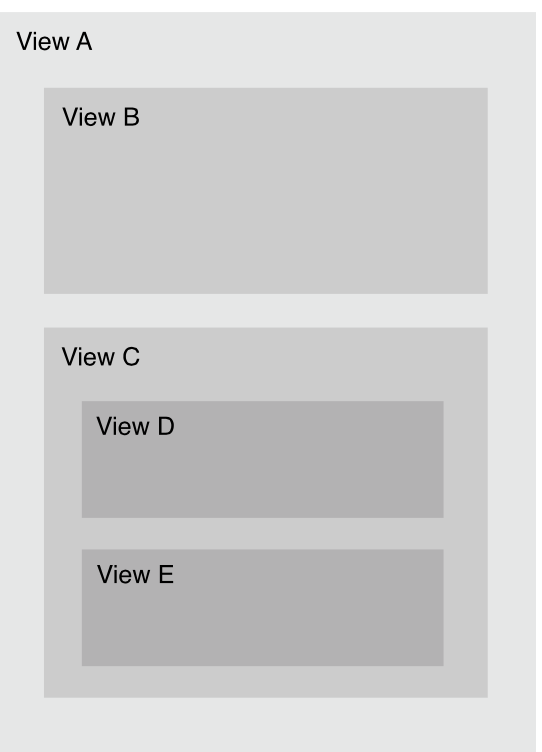
- The touch is within the bounds of view A, so it checks subviews B and C.
- The touch is not within the bounds of view B, but it’s within the bounds of view C, so it checks subviews D and E.
- The touch is not within the bounds of view D, but it’s within the bounds of view E. View E is the lowest view in the view hierarchy that contains the touch, so it becomes the hit-test view.
这里有两个主要的方法,一个是hitTest:withEvent方法。一个是pointInside:withEvent会返回点击的view。当然这个方法会调用pointInside: withEvent:来判断是否点击的区域在view中。 如果点击到的点不在view区域中,pointInside:withEvent会返回NO。hitTest:withEvent将会返回nil.如果一个点击事件的父view返回了nil,这里 子view肯定不会收到touch events.
The Responder Chain Is Made Up of Responder Objects
这里hit-test view有拥有优先的机会,如果不能处理这个事件,这里将会根据Responder Chain来传递这个事件。 这里UIResponder是responder对象的基本类,UIApplication,UIViewController,UIView都是responders,这些都可以作为responder Chain 中的一员。这里注意Core Animation layes不是responders. The first responder被设计作为第一个事件接收对象,一个对象想成为第一接收对象。这里需要做两件事。 1)覆盖 canBecomeFirestResponder 方法,返回YES. 2)收到一个becomeFirstResponder消息,如果可能,一个对象能对自己发这类消息。
这里最好在viewDidAppear这个地方,调用becomeFirstResponder方法。如果过早的话,becomeFirstRespnder会返回NO. 这里UIKit自动设置the text field或者text view成为第一响应者,其他的需要手动设置becomeFirstReponder方法。
The Responder Chain Follows a Specific Delivery Path
如下有两个例子可以说明一下这个responder chain传递的顺序。
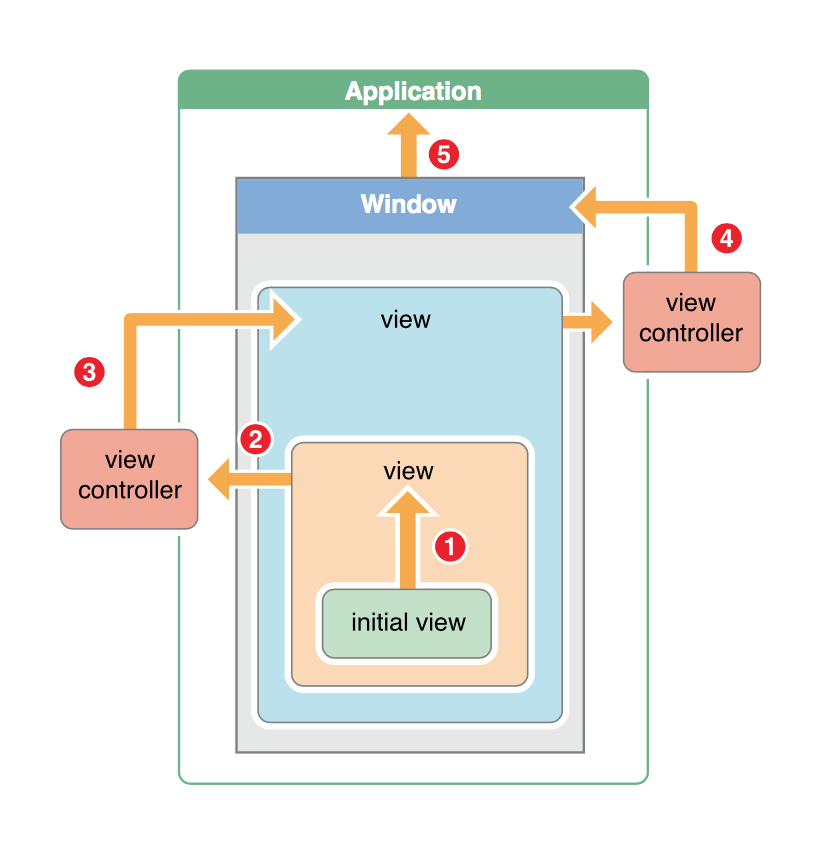 1、initial view 首先处理这个事件,如果不能处理,会给他得superview.当然这是因为view不是他view controler的最底层的view。
2、superview 也处理这个事件,搞不定继续向上传递,当然条件如第一条
3、到了最底层的view,这里搞不定,需要把事件传递给view的view controller
4、view controller搞不定,这里就需要把事件传递给window.
5、window搞不定传递给app object.
1、initial view 首先处理这个事件,如果不能处理,会给他得superview.当然这是因为view不是他view controler的最底层的view。
2、superview 也处理这个事件,搞不定继续向上传递,当然条件如第一条
3、到了最底层的view,这里搞不定,需要把事件传递给view的view controller
4、view controller搞不定,这里就需要把事件传递给window.
5、window搞不定传递给app object.
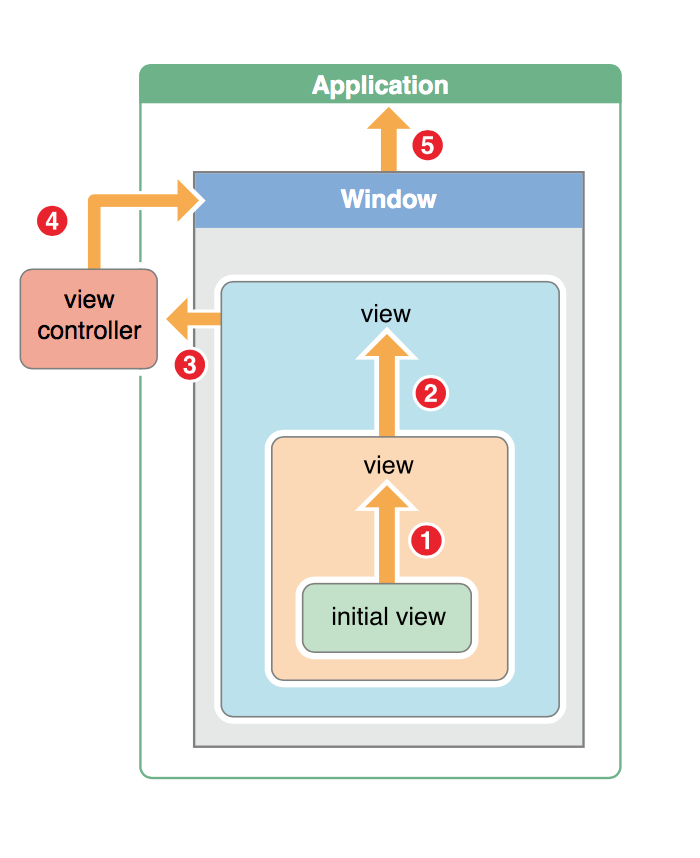 这里因为view层级和view controller的设计不同,有一点区别,但传递的原则是一样的。
1、initial view 首先处理这个事件,如果不能处理,会给他得superview.一直到最底层的view.
2、view 传递给view controller
3、搞不定,传递给最底层view的superview(这里是有多个view controller)
4、一直传递到root view controller都搞不定,就会传递给window。
5、window搞不定传递给app object.
这里有个小的提示,最好不要自己直接将事件传递给nextResponder.而是遵守这么一个reponder chain的规则,
利用UIKit来管理这个事件的传递。
这里因为view层级和view controller的设计不同,有一点区别,但传递的原则是一样的。
1、initial view 首先处理这个事件,如果不能处理,会给他得superview.一直到最底层的view.
2、view 传递给view controller
3、搞不定,传递给最底层view的superview(这里是有多个view controller)
4、一直传递到root view controller都搞不定,就会传递给window。
5、window搞不定传递给app object.
这里有个小的提示,最好不要自己直接将事件传递给nextResponder.而是遵守这么一个reponder chain的规则,
利用UIKit来管理这个事件的传递。
Multitouch Events
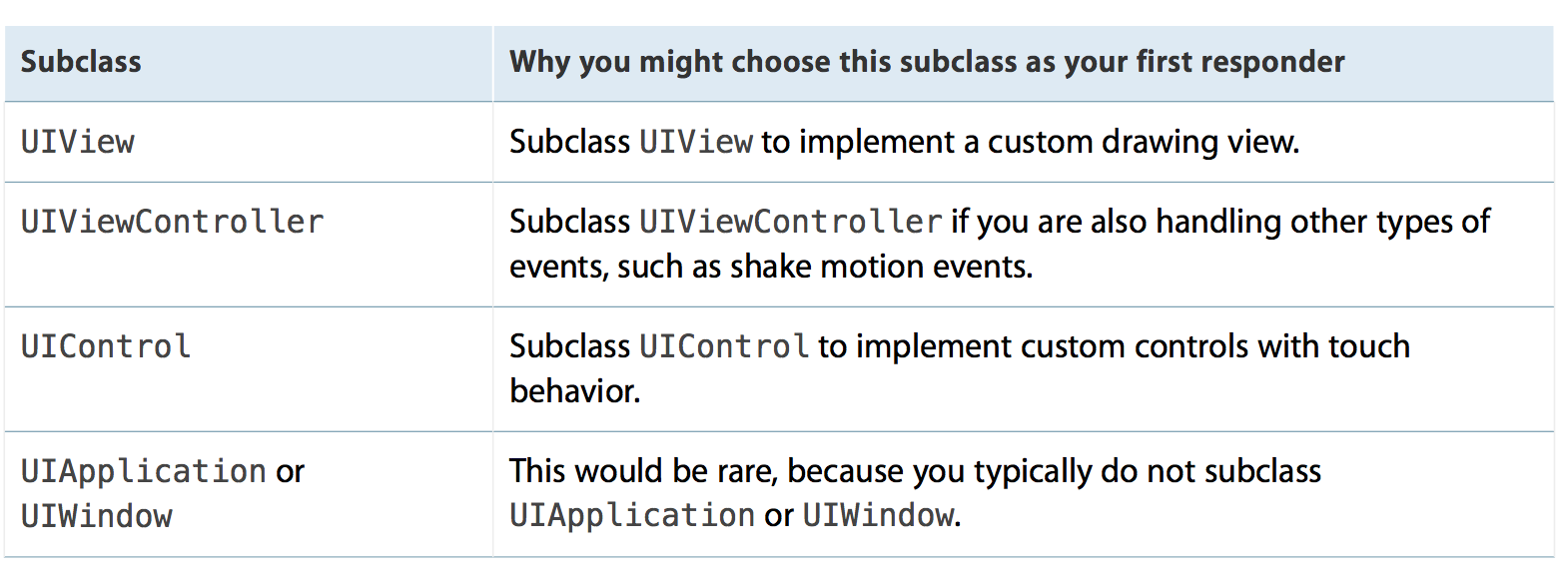 当然实现了一些上述的子类以后,你需要注意如下的几点:
1)你的子类必须实现UIResponder的方法,重要的还是那4个方法
2)view子类,需要设置userInteractionEnabled属性为YES.如果是一个view controller,管理的view需要设置为YES
3) view收到事件的时候,必须是可见的,也就是不能是隐藏的
当然实现了一些上述的子类以后,你需要注意如下的几点:
1)你的子类必须实现UIResponder的方法,重要的还是那4个方法
2)view子类,需要设置userInteractionEnabled属性为YES.如果是一个view controller,管理的view需要设置为YES
3) view收到事件的时候,必须是可见的,也就是不能是隐藏的
Implementing the Touch-Event Handling Methods in Your Subclass
就是如下4个提了再提得方法 - (void)touchesBegan:(NSSet *)touches withEvent:(UIEvent *)event; - (void)touchesMoved:(NSSet *)touches withEvent:(UIEvent *)event; - (void)touchesEnded:(NSSet *)touches withEvent:(UIEvent *)event; - (void)touchesCancelled:(NSSet *)touches withEvent:(UIEvent *)event;
我们可以发现每个方法都有两个参数,第一个参数是UITouch的一个集合,代表是这个阶段新的或者是改变的touches.而UIEvent是包含整个touche事件的。 所有的view都是期望收到整个touch-event流的,所以你需要注意以下几点 1)如果是UIView或者UIViewController的子类,你需要实现所有的方法 2)如果你事其他的一些reponder子类,你可以实现部分方法 3)记得所有你实现的方法中,都需要调用一些父类的方法。
如果一个reponder在处理events的时候创建了一些objects,那他需要实现touchesCanceller:withEvent来做一些reset的工作。 当然这里也需要实现一些touchesEnded:withEvent的方法,来在一次事件处理完成以后,进行一些reset的工作。
Tracking the Phase and Location of a Touch Event
这里iOS会存储一些相关的信息,一个touch对象存储了touch事件出现的window,点击的view,准确的坐标地址。
Retrieving and Querying Touch Objects
这里可以调用allTouches来获得所有的touch
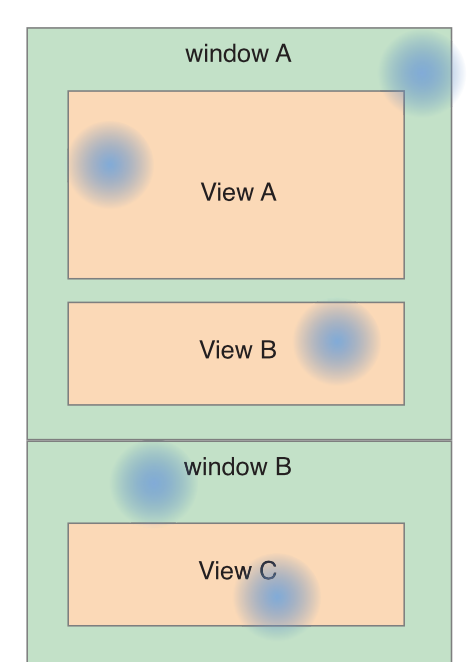
当然你也可以只对特定window的touch感兴趣,你可以调用touchesForWindow:方法
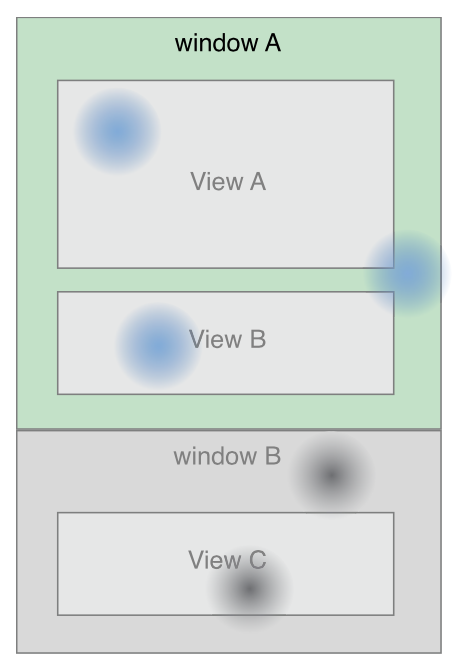
或者说你只对特定view上的touch感兴趣,你可以调用touchesForView:方法
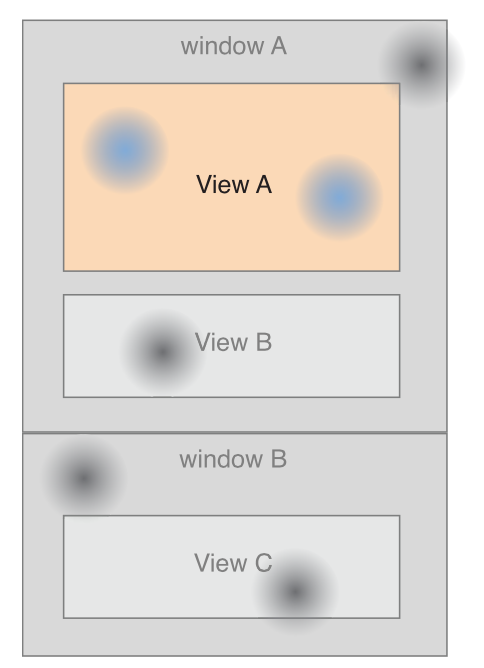
Handling Tap Gestures
这里话不多说,对于点击事件的一个判断的例子
- (void)touchesBegan:(NSSet *)touches withEvent:(UIEvent *)event {
}
- (void)touchesMoved:(NSSet *)touches withEvent:(UIEvent *)event {
}
- (void)touchesEnded:(NSSet *)touches withEvent:(UIEvent *)event {
for (UITouch *aTouch in touches) {
if (aTouch.tapCount >= 2) {
// The view responds to the tap
[self respondToDoubleTapGesture:aTouch];
} }
}
- (void)touchesCancelled:(NSSet *)touches withEvent:(UIEvent *)event {
}
Handling Swipe and Drag Gestures
#define HORIZ_SWIPE_DRAG_MIN 12
#define VERT_SWIPE_DRAG_MAX 4
- (void)touchesBegan:(NSSet *)touches withEvent:(UIEvent *)event {
UITouch *aTouch = [touches anyObject];
// startTouchPosition is a property
self.startTouchPosition = [aTouch locationInView:self];
}
- (void)touchesMoved:(NSSet *)touches withEvent:(UIEvent *)event {
}
- (void)touchesEnded:(NSSet *)touches withEvent:(UIEvent *)event {
UITouch *aTouch = [touches anyObject];
CGPoint currentTouchPosition = [aTouch locationInView:self];
// Check if direction of touch is horizontal and long enough
if (fabsf(self.startTouchPosition.x - currentTouchPosition.x) >=
HORIZ_SWIPE_DRAG_MIN &&
fabsf(self.startTouchPosition.y - currentTouchPosition.y) <=
VERT_SWIPE_DRAG_MAX)
{
// If touch appears to be a swipe
if (self.startTouchPosition.x < currentTouchPosition.x) {
[self myProcessRightSwipe:touches withEvent:event];
} else {
[self myProcessLeftSwipe:touches withEvent:event];
}
self.startTouchPosition = CGPointZero;
}
- (void)touchesCancelled:(NSSet *)touches withEvent:(UIEvent *)event {
self.startTouchPosition = CGPointZero;
}
当然这个检测是比较简单的,这里需要检测一下中间的状态。下面这个例子就是与中间过程有关。
- (void)touchesBegan:(NSSet *)touches withEvent:(UIEvent *)event {
}
- (void)touchesMoved:(NSSet *)touches withEvent:(UIEvent *)event {
UITouch *aTouch = [touches anyObject];
CGPoint loc = [aTouch locationInView:self];
CGPoint prevloc = [aTouch previousLocationInView:self];
CGRect myFrame = self.frame;
float deltaX = loc.x - prevloc.x;
float deltaY = loc.y - prevloc.y;
myFrame.origin.x += deltaX;
myFrame.origin.y += deltaY;
[self setFrame:myFrame];
}
- (void)touchesEnded:(NSSet *)touches withEvent:(UIEvent *)event {
}
- (void)touchesCancelled:(NSSet *)touches withEvent:(UIEvent *)event {
}
Handling a Complex Multitouch Sequence
当然总是会有一些复杂的动作,这里为了识别这种多点的触摸。应该做以下两件事情。 1、设置multipleTouchEnabled 属性为YES 2、使用Core Foundation的dictionary object(CFDictionaryRef)
需要注意的是这里使用CFDictionaryRef对象而不是NSDitionary对象,因为UITouch类没有实现NSCopying协议。
Specifying Custom Touch Event Behavior
这里你可以通过设置一些属性来调整事件响应的一些方式。
1)Turn on delivery of multiple touches. 可以设置multipleTouchEnabled属性为YES,使得支持多点触控。
2) Restrict event delivery to a single view. 这里通过设置exclusiveTouch,如果设置为YES,表明这个
view必须是touches事件都是这个view上才会收到touches事件。
这里有一个例子,A设置了exclusive为YES,B和C设置为NO。如果一个用户触摸到了view A.这里会去识别,但是如果
触摸到view A 同时也触摸到view B。这里A就不会收到这个touches事件。这里B也不会收到这个事件。如果用户触摸到
B的同时也触摸到C,这里B和C都能收到相应的touches. 这里可以简化一些事件的处理。

3)Restrict event delivery to subviews,这里可以通过覆盖hitTest:withEvent:使得events不会传递到 指定的子view中。 4)Turn off delivery of touch events。 这里可以通过设置userInteractionEnabled属性使得view不会传递这个事件。 5)Turn off delivery of touch events for a period。有时候你只是想临时取消关闭一下事件传递,你可以使用 beginIgnoringInteractionEvents来关闭,再用endIgnoringInteractionEvents来恢复。
Intercepting Touches by Overriding Hit-Testing
如果你有一个view,并且有一些子view。你想都用父view来处理这些事件。这里你需要修改这个hitTest:withEvent:方法。
Forwarding Touch Events
这里有一个特殊的用法,将事件的处理转发出去。这里需要小心一点,因为如果不是在你view范围内的,你收到了这个事件 你需要处理这种情况。这里需要使用sendEvent这个方法.
Best Practices for Handling Multitouch Events
目前有一些建议,可以参考一下。 1)总是实现事件取消的方法。如果你在处理的过程中有一些中间状态的保存,在取消的时候需要重置这些状态。 2)如果你处理事件是在UIView,UIViewController,UIResponder的子类,实现所有的方法,即使是什么都不做。 不要调用父类的实现方法 3)如果你处理是在其他的UIKit的响应类的子类。不需要实现所有的方法,这里需要调用父类的实现方法。 4)不要转发events给UIKit framework的其他响应对象。最好是转发events给uiview的子类。 5)不要显示的调用nextResponder方法 6)这里对于点最好不好转换成整数,容易失去精准度。